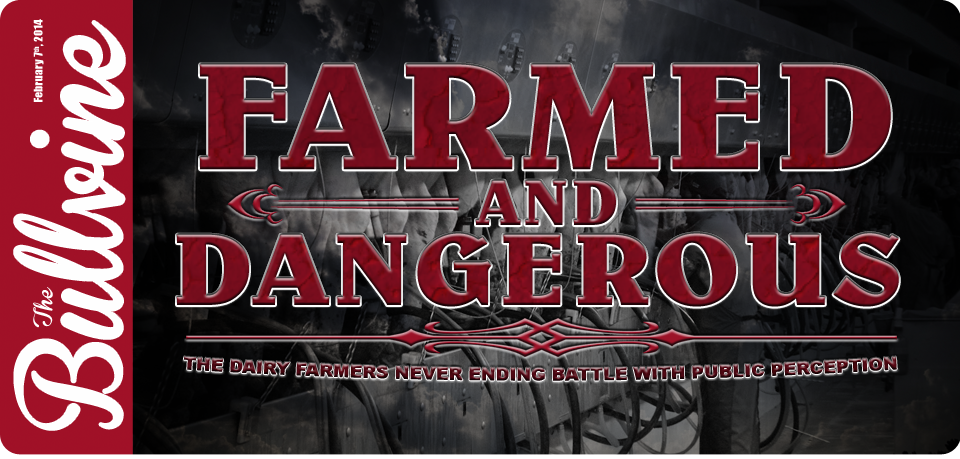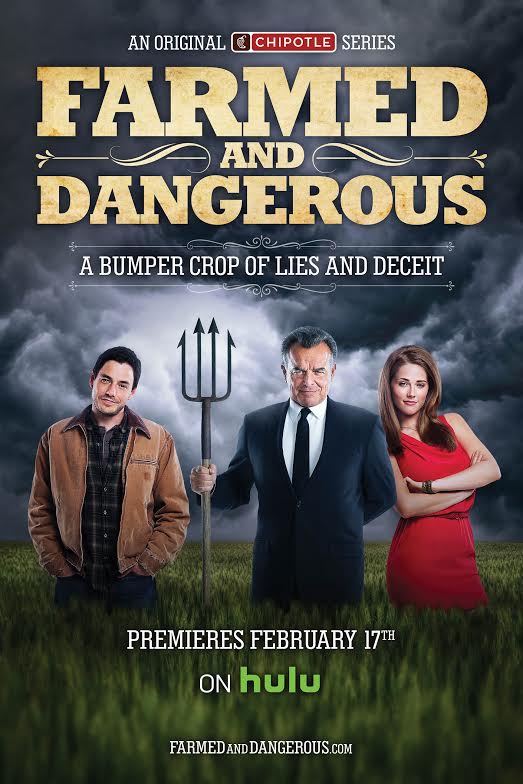Chipotle Mexican Grill is not new to pushing the edge with their advertising. This time they have plans to launch “Farmed and Dangerous,” a Chipotle original comedy series that satirically explores the world of industrial agriculture in America. (Read more: Chipotle to Launch “Farmed and Dangerous”) When I saw this, ad it brought to light again the constant battle farmers and especially dairy farmers face when dealing with public perception.
There is no question that consumers want their food to be fresh, cheap and 100% natural. With the emphasis being that, they want it cheap. All consumers would like to believe that the milk they drink comes from cows that roam lush green pastures and frolic with their friends all day long. The challenge of course is that it just doesn’t happen that way. In order to produce the volumes of milk that is needed at the lowest cost, the need for larger “agribusinesses” or the negatively perceived “factory” farms is not a choice but a necessity. The thing is any well run dairy operation knows the first requirement for maximum efficiency and production comes down to how well you treat your cows and how comfortable they are. Cow comfort is one of the biggest indicators of profitability on any dairy. If the cows are well fed and comfortable, the dairy is running at peak efficiency, even “factory farms.”
That is why this new “Farmed and Dangerous” video from Chipotle offends me as much as it does. Over the years, I have had the opportunity to walk among the cows on many large farms. The consistent management goal found on all of them is maximizing cow comfort. I recently watched an informative video by National Geographic – Megafactories about a 135,000 head dairy in Saudi Arabia owned by Almarai.
The problem is that messages like the one from National Geographic get lost. Instead consumers see repeated messages like the one by Chipotle and assume that they are seeing the way things really are. Since starting the Bullvine, we have tried to do our part to provide consumers with an accurate and positive perception of dairy farming… (Read more: Dairy Carrie – Diary of a City Kid Gone Country, Michele Payn-Knoper – Standing Up and Speaking Out for Agriculture!! and TOM HOOGENDOORN- Family man, Farmer & Our Face to the Consumer!). Unfortunately, the challenge is that the message is simply not making it through to the general consumer often enough or clearly enough. Yes large agribusinesses do try to put a positive spin on food production and I get it that it’s not always as sweet and rosie as the image they would have you believe. Having said that, they certainly don’t need companies like Chipotle undermining these efforts.
I have been fortunate over the years to be exposed to many different cultures and backgrounds. This has led to a very diverse group of friends on my Facebook feed. Since I post all the Bullvine featured articles on my Facebook wall, I often get interesting feedback from those who do not come from a dairy background. While most often questions about arise from them wanting to understand what this whole “Genomics” thing is about, the interaction gets me thinking about the effect our Facebook feeds have on the general consumer’s understanding of agriculture and milk production.
With this in mind, I started looking through my list of dairy friends’ Facebook posts. For the most part, it was just the same as any other groups, except there are a lot of pictures of cows. With #felfie’s and other pictures adding a nice touch. Then I started to see some things that most consumers would just not understand. One such piece of content was a trend that is going viral, #necknominations. Necknominations is a drinking game where participants film themselves “necking” liquor, then nominate a friend to do so as well. This was not the first time I had seen these. I have actually seen many. After one such time, a fellow dairy industry member wondered what effect this would have on the general consumer’s perception of dairy farmers. As I think about this, I find that, while it’s not a “positive” thing for dairy farmers, it certainly is not an isolated event for them either. It has become viral worldwide. Unfortunately it even lead to the death of a young man. This really has me thinking about the power of Facebook on consumer perception.
What I have come to realize is that Facebook does have great power and it can be in a very positive way. I have seen items like the poem (Just a cow) that highlights just how much dairy farmer’s love for their cows can go viral along with the stories that share the day-to-day challenges that all dairy farmers face in producing clean, wholesome milk.
One video that I think does a great job of showing exactly what it means to be a dairy farmer, is the recent video the Canadian Dairy Xpo produced called “So God Made a Dairy Farmer”. Working off the very viral Super Bowl commercial by Dodge Ram, this video is narrated by the unique voice and great dairy advocate and legendary auctioneer, David Carson.
It highlights the daily challenges dairy farmers face and it is messages like this one that I wish more consumers would see and relate to. Please like and share this in your Facebook feed, so that more consumers can understand exactly what it means to be a dairy farmer.
The Bullvine Bottom Line
There is no question that as the world’s population grows, there is going to be greater and greater demand for dairy products. With that comes the pressure on prices, which will lead to larger and larger dairy farms. While I understand we all don’t have the time to take up consumer education like Dairy Carrie or Michele Payn-Knoper, there are effective things that each of us can l do. On your Facebook feed, be sure to post as many positive images of dairy farming as you can. Whether that is a new born calf (yes Jerry Jorgenson, you do this well!) and be sure to let consumers know just how much you love what you are doing and the pride you have in taking great care of your dairy cattle. Real farmers actively sharing and communicating is definitely the most honest and effective way to give consumers a positive perception. While it may not seem like much, every little bit helps!?”
To learn how to get your farm on Facebook download this free guide.



















I have been coming to Bullvine for awhile now because I like good cows and there’s a lot of information here. You liked to say,” Let’s start with what we are not. We’re not just an event reporting magazine. We’re not a billboard or promoter of whoever will pay us the most money. We are something different, something real.” But I have come to the conclusion that what you are is a promoter of industrialized dairy farming. As someone who is going on my 38th year of dairy farming milking 50 cows, I can’t disagree with your publication enough when it comes to the last man standing philosophy that I feel you promote. I have no problem with the idea that large farms run right are more profitable, but the belief that being large makes them more efficient is pure bunk.
Lyle,
I am not saying that all large herds are more efficient. What we are saying is that large herds benefit from economies of scale. So in a relative lower priced milk market, such as the US, these benefits come to the forefront, and allow them to compete easier than a smaller operations. Its more an issue of two factors, labor and feed efficiency. These two metrics will certainly indicated the profitability of most herds. Since these are two of the greatest costs on most operations. More lbs. per labor unit is certainly one of the advantages of size. As is the ability to purchase/produce feed in a much more cost effective manner.
Andrew
You have me confused Andrew. If the large herds benefit from the economies of scale, isn’t that about efficiency? If both large and small dairy farms need a COP of $15 lets say, and they receive $13 for their milk, how does economy of scale help? There are literally hundreds of ways on dairy farms to gain efficiencies. As I have said, I really like your publication, you put a lot of work into it, but I disagree with your push for the failed and corrupt U.S. milk pricing model that we have here, and the idea that bigger is better.
Who said they both need $15, that is an incorrect assumption.
Choose whatever COP you like. My point is, if both large and small dairies receive the same milk price and it’s below their COP, economies of scale doesn’t help the large dairy. It’s a myth that well run large farms are more efficient well run small ones when it comes to COP. Too many people confuse efficiency with profitability. They’re not the same
Why do you assume that all dairies have a cost of production higher than milk price?
I’m not assuming that. I’m making the point that efficiency and profitability are not one and the same. As I have said before, Bullvine is an outstanding source of breeder information which is why come here. Where I take issue is Bullvine’s enthusiasm for U.S. style race to the bottom dairy economics.